E-Cigarette Efficacy: A Comprehensive Report on Smoking Cessation
VerifiedAdded on 2023/06/03
|8
|2139
|391
Report
AI Summary
This report critically evaluates the effectiveness of e-cigarettes as a smoking cessation aid compared to nicotine replacement therapies (NRT), using Joanne's case scenario as a focal point. It assesses the strengths and limitations of existing research, including sample size, data collection methods, and potential biases, while also examining the research questions, design, and methods employed in studies on e-cigarette efficacy. The report highlights findings that suggest e-cigarettes can be an efficient therapy for quitting smoking, though concerns remain about the safety and long-term health implications, including the potential for addiction and lung cancer. Ultimately, the report concludes that while e-cigarettes may hold promise, more research is needed to fully understand their efficacy and safety before widespread clinical application can be recommended, suggesting a combined approach with other therapies may be more beneficial.
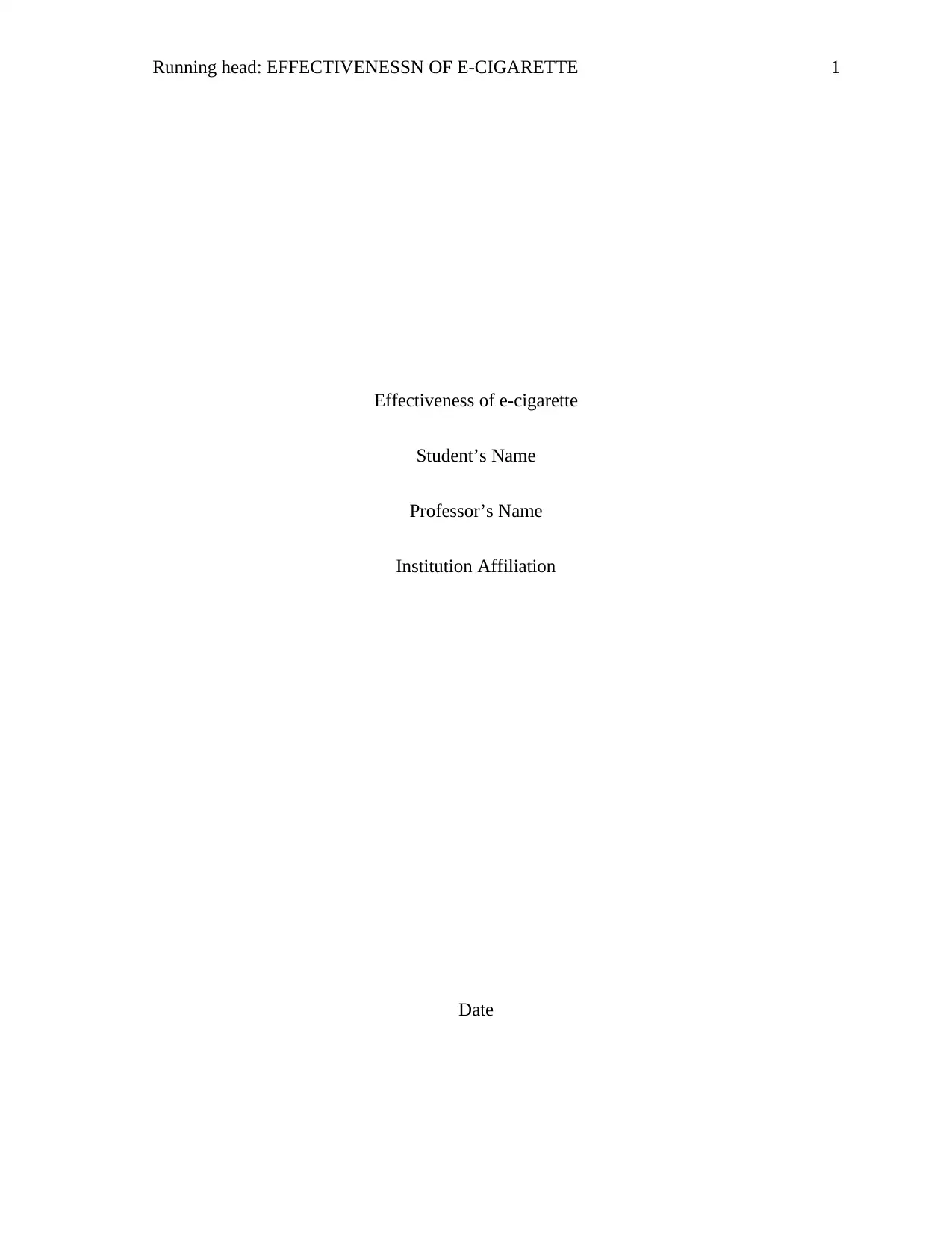
Running head: EFFECTIVENESSN OF E-CIGARETTE 1
Effectiveness of e-cigarette
Student’s Name
Professor’s Name
Institution Affiliation
Date
Effectiveness of e-cigarette
Student’s Name
Professor’s Name
Institution Affiliation
Date
Paraphrase This Document
Need a fresh take? Get an instant paraphrase of this document with our AI Paraphraser
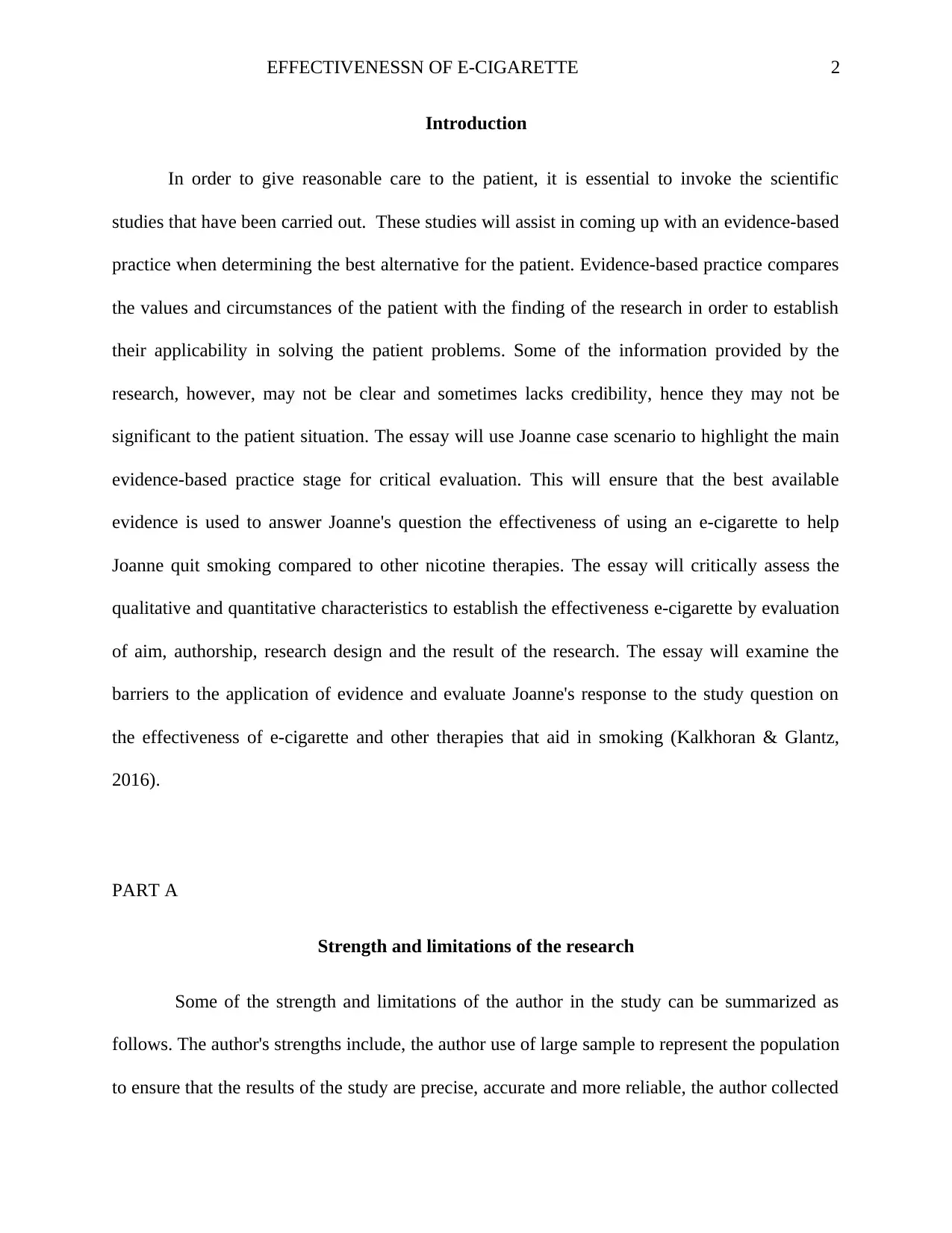
EFFECTIVENESSN OF E-CIGARETTE 2
Introduction
In order to give reasonable care to the patient, it is essential to invoke the scientific
studies that have been carried out. These studies will assist in coming up with an evidence-based
practice when determining the best alternative for the patient. Evidence-based practice compares
the values and circumstances of the patient with the finding of the research in order to establish
their applicability in solving the patient problems. Some of the information provided by the
research, however, may not be clear and sometimes lacks credibility, hence they may not be
significant to the patient situation. The essay will use Joanne case scenario to highlight the main
evidence-based practice stage for critical evaluation. This will ensure that the best available
evidence is used to answer Joanne's question the effectiveness of using an e-cigarette to help
Joanne quit smoking compared to other nicotine therapies. The essay will critically assess the
qualitative and quantitative characteristics to establish the effectiveness e-cigarette by evaluation
of aim, authorship, research design and the result of the research. The essay will examine the
barriers to the application of evidence and evaluate Joanne's response to the study question on
the effectiveness of e-cigarette and other therapies that aid in smoking (Kalkhoran & Glantz,
2016).
PART A
Strength and limitations of the research
Some of the strength and limitations of the author in the study can be summarized as
follows. The author's strengths include, the author use of large sample to represent the population
to ensure that the results of the study are precise, accurate and more reliable, the author collected
Introduction
In order to give reasonable care to the patient, it is essential to invoke the scientific
studies that have been carried out. These studies will assist in coming up with an evidence-based
practice when determining the best alternative for the patient. Evidence-based practice compares
the values and circumstances of the patient with the finding of the research in order to establish
their applicability in solving the patient problems. Some of the information provided by the
research, however, may not be clear and sometimes lacks credibility, hence they may not be
significant to the patient situation. The essay will use Joanne case scenario to highlight the main
evidence-based practice stage for critical evaluation. This will ensure that the best available
evidence is used to answer Joanne's question the effectiveness of using an e-cigarette to help
Joanne quit smoking compared to other nicotine therapies. The essay will critically assess the
qualitative and quantitative characteristics to establish the effectiveness e-cigarette by evaluation
of aim, authorship, research design and the result of the research. The essay will examine the
barriers to the application of evidence and evaluate Joanne's response to the study question on
the effectiveness of e-cigarette and other therapies that aid in smoking (Kalkhoran & Glantz,
2016).
PART A
Strength and limitations of the research
Some of the strength and limitations of the author in the study can be summarized as
follows. The author's strengths include, the author use of large sample to represent the population
to ensure that the results of the study are precise, accurate and more reliable, the author collected
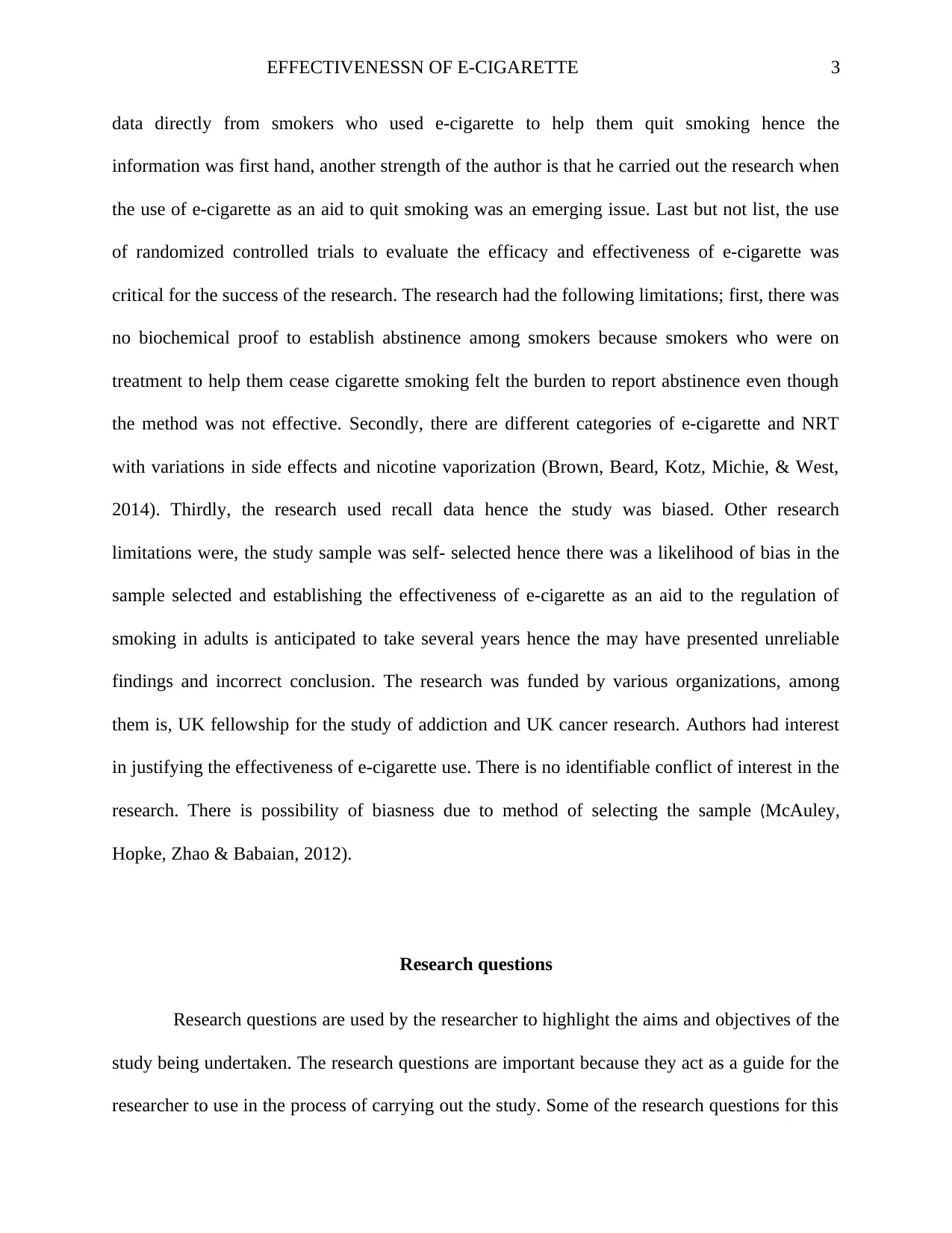
EFFECTIVENESSN OF E-CIGARETTE 3
data directly from smokers who used e-cigarette to help them quit smoking hence the
information was first hand, another strength of the author is that he carried out the research when
the use of e-cigarette as an aid to quit smoking was an emerging issue. Last but not list, the use
of randomized controlled trials to evaluate the efficacy and effectiveness of e-cigarette was
critical for the success of the research. The research had the following limitations; first, there was
no biochemical proof to establish abstinence among smokers because smokers who were on
treatment to help them cease cigarette smoking felt the burden to report abstinence even though
the method was not effective. Secondly, there are different categories of e-cigarette and NRT
with variations in side effects and nicotine vaporization (Brown, Beard, Kotz, Michie, & West,
2014). Thirdly, the research used recall data hence the study was biased. Other research
limitations were, the study sample was self- selected hence there was a likelihood of bias in the
sample selected and establishing the effectiveness of e-cigarette as an aid to the regulation of
smoking in adults is anticipated to take several years hence the may have presented unreliable
findings and incorrect conclusion. The research was funded by various organizations, among
them is, UK fellowship for the study of addiction and UK cancer research. Authors had interest
in justifying the effectiveness of e-cigarette use. There is no identifiable conflict of interest in the
research. There is possibility of biasness due to method of selecting the sample (McAuley,
Hopke, Zhao & Babaian, 2012).
Research questions
Research questions are used by the researcher to highlight the aims and objectives of the
study being undertaken. The research questions are important because they act as a guide for the
researcher to use in the process of carrying out the study. Some of the research questions for this
data directly from smokers who used e-cigarette to help them quit smoking hence the
information was first hand, another strength of the author is that he carried out the research when
the use of e-cigarette as an aid to quit smoking was an emerging issue. Last but not list, the use
of randomized controlled trials to evaluate the efficacy and effectiveness of e-cigarette was
critical for the success of the research. The research had the following limitations; first, there was
no biochemical proof to establish abstinence among smokers because smokers who were on
treatment to help them cease cigarette smoking felt the burden to report abstinence even though
the method was not effective. Secondly, there are different categories of e-cigarette and NRT
with variations in side effects and nicotine vaporization (Brown, Beard, Kotz, Michie, & West,
2014). Thirdly, the research used recall data hence the study was biased. Other research
limitations were, the study sample was self- selected hence there was a likelihood of bias in the
sample selected and establishing the effectiveness of e-cigarette as an aid to the regulation of
smoking in adults is anticipated to take several years hence the may have presented unreliable
findings and incorrect conclusion. The research was funded by various organizations, among
them is, UK fellowship for the study of addiction and UK cancer research. Authors had interest
in justifying the effectiveness of e-cigarette use. There is no identifiable conflict of interest in the
research. There is possibility of biasness due to method of selecting the sample (McAuley,
Hopke, Zhao & Babaian, 2012).
Research questions
Research questions are used by the researcher to highlight the aims and objectives of the
study being undertaken. The research questions are important because they act as a guide for the
researcher to use in the process of carrying out the study. Some of the research questions for this
⊘ This is a preview!⊘
Do you want full access?
Subscribe today to unlock all pages.

Trusted by 1+ million students worldwide
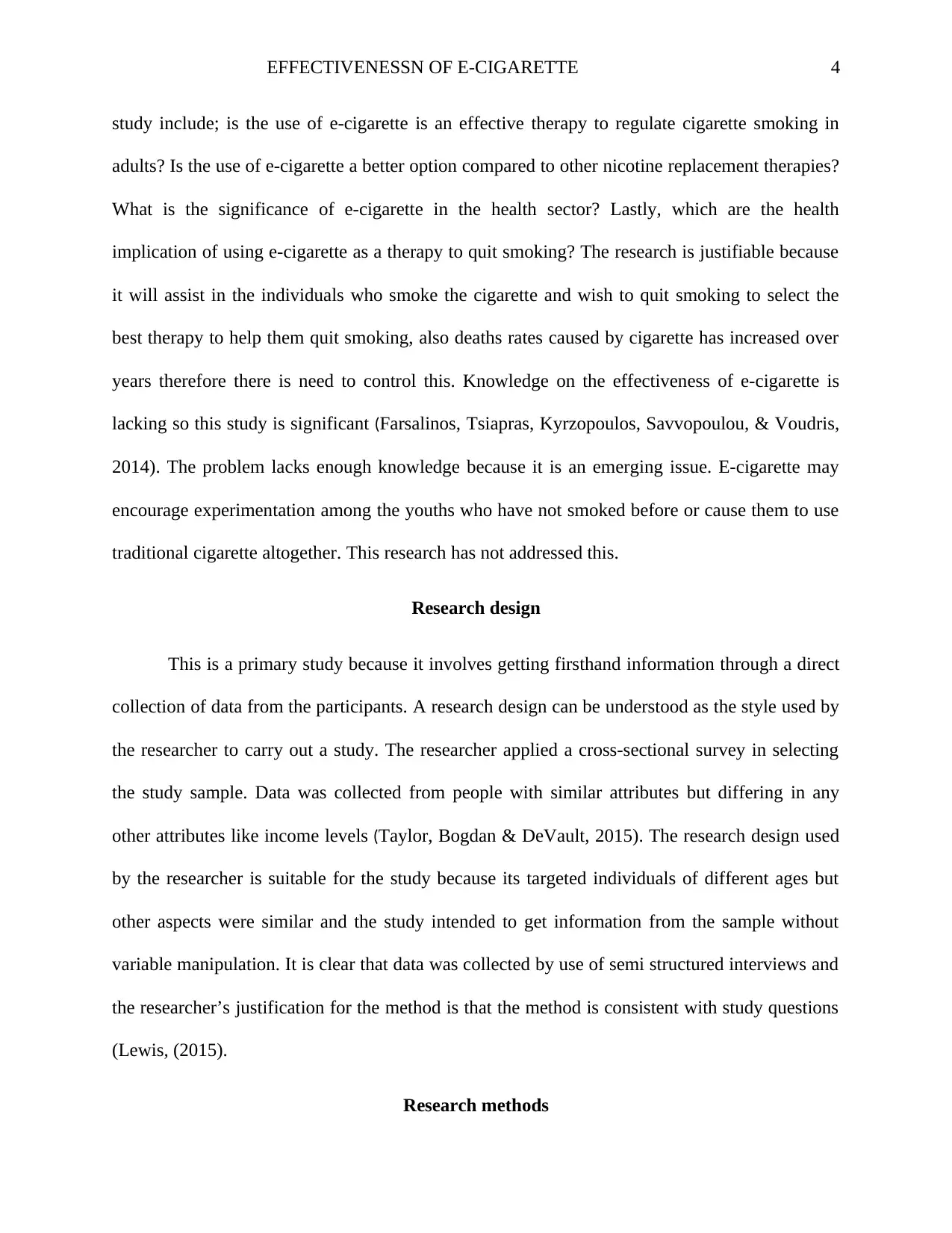
EFFECTIVENESSN OF E-CIGARETTE 4
study include; is the use of e-cigarette is an effective therapy to regulate cigarette smoking in
adults? Is the use of e-cigarette a better option compared to other nicotine replacement therapies?
What is the significance of e-cigarette in the health sector? Lastly, which are the health
implication of using e-cigarette as a therapy to quit smoking? The research is justifiable because
it will assist in the individuals who smoke the cigarette and wish to quit smoking to select the
best therapy to help them quit smoking, also deaths rates caused by cigarette has increased over
years therefore there is need to control this. Knowledge on the effectiveness of e-cigarette is
lacking so this study is significant (Farsalinos, Tsiapras, Kyrzopoulos, Savvopoulou, & Voudris,
2014). The problem lacks enough knowledge because it is an emerging issue. E-cigarette may
encourage experimentation among the youths who have not smoked before or cause them to use
traditional cigarette altogether. This research has not addressed this.
Research design
This is a primary study because it involves getting firsthand information through a direct
collection of data from the participants. A research design can be understood as the style used by
the researcher to carry out a study. The researcher applied a cross-sectional survey in selecting
the study sample. Data was collected from people with similar attributes but differing in any
other attributes like income levels (Taylor, Bogdan & DeVault, 2015). The research design used
by the researcher is suitable for the study because its targeted individuals of different ages but
other aspects were similar and the study intended to get information from the sample without
variable manipulation. It is clear that data was collected by use of semi structured interviews and
the researcher’s justification for the method is that the method is consistent with study questions
(Lewis, (2015).
Research methods
study include; is the use of e-cigarette is an effective therapy to regulate cigarette smoking in
adults? Is the use of e-cigarette a better option compared to other nicotine replacement therapies?
What is the significance of e-cigarette in the health sector? Lastly, which are the health
implication of using e-cigarette as a therapy to quit smoking? The research is justifiable because
it will assist in the individuals who smoke the cigarette and wish to quit smoking to select the
best therapy to help them quit smoking, also deaths rates caused by cigarette has increased over
years therefore there is need to control this. Knowledge on the effectiveness of e-cigarette is
lacking so this study is significant (Farsalinos, Tsiapras, Kyrzopoulos, Savvopoulou, & Voudris,
2014). The problem lacks enough knowledge because it is an emerging issue. E-cigarette may
encourage experimentation among the youths who have not smoked before or cause them to use
traditional cigarette altogether. This research has not addressed this.
Research design
This is a primary study because it involves getting firsthand information through a direct
collection of data from the participants. A research design can be understood as the style used by
the researcher to carry out a study. The researcher applied a cross-sectional survey in selecting
the study sample. Data was collected from people with similar attributes but differing in any
other attributes like income levels (Taylor, Bogdan & DeVault, 2015). The research design used
by the researcher is suitable for the study because its targeted individuals of different ages but
other aspects were similar and the study intended to get information from the sample without
variable manipulation. It is clear that data was collected by use of semi structured interviews and
the researcher’s justification for the method is that the method is consistent with study questions
(Lewis, (2015).
Research methods
Paraphrase This Document
Need a fresh take? Get an instant paraphrase of this document with our AI Paraphraser
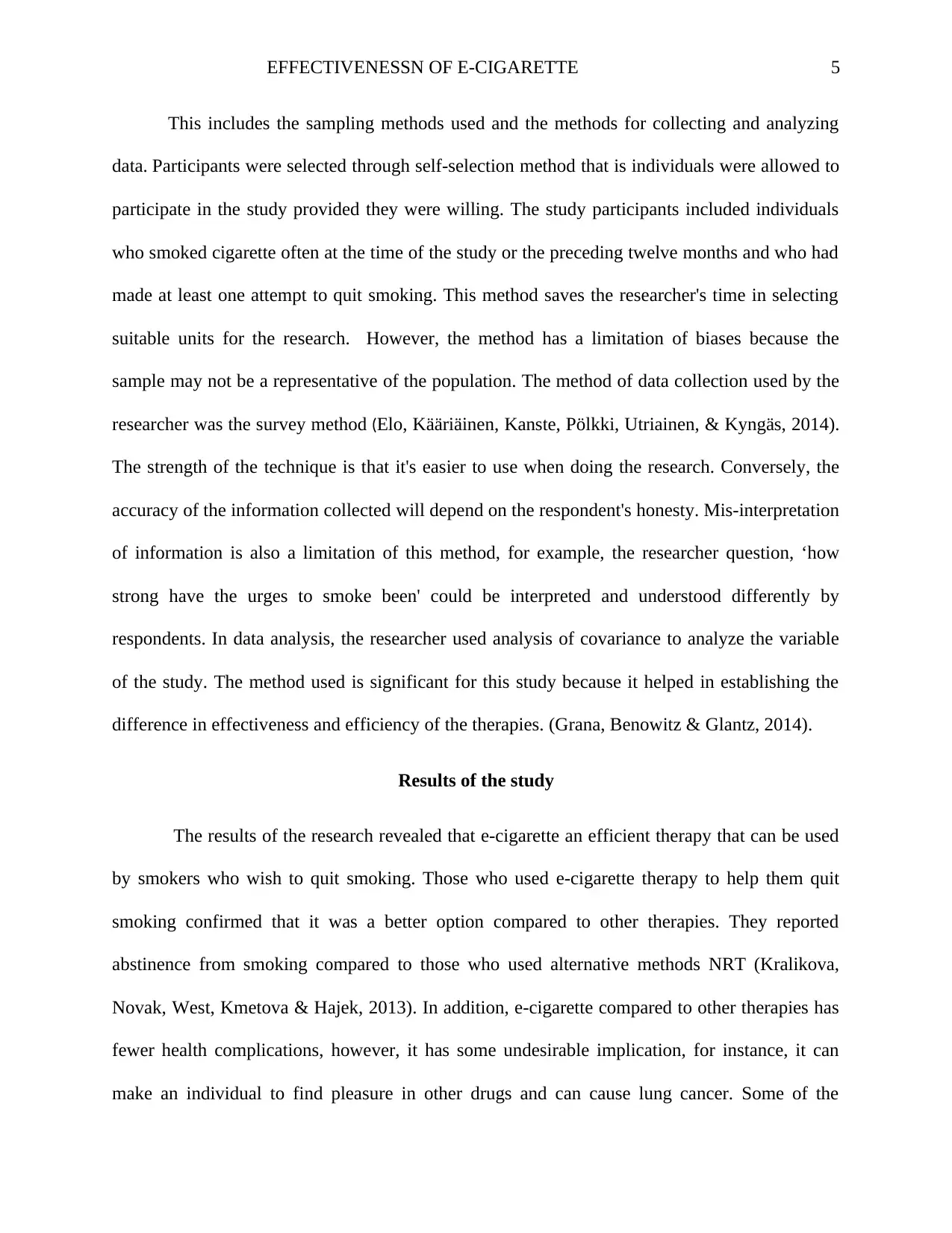
EFFECTIVENESSN OF E-CIGARETTE 5
This includes the sampling methods used and the methods for collecting and analyzing
data. Participants were selected through self-selection method that is individuals were allowed to
participate in the study provided they were willing. The study participants included individuals
who smoked cigarette often at the time of the study or the preceding twelve months and who had
made at least one attempt to quit smoking. This method saves the researcher's time in selecting
suitable units for the research. However, the method has a limitation of biases because the
sample may not be a representative of the population. The method of data collection used by the
researcher was the survey method (Elo, Kääriäinen, Kanste, Pölkki, Utriainen, & Kyngäs, 2014).
The strength of the technique is that it's easier to use when doing the research. Conversely, the
accuracy of the information collected will depend on the respondent's honesty. Mis-interpretation
of information is also a limitation of this method, for example, the researcher question, ‘how
strong have the urges to smoke been' could be interpreted and understood differently by
respondents. In data analysis, the researcher used analysis of covariance to analyze the variable
of the study. The method used is significant for this study because it helped in establishing the
difference in effectiveness and efficiency of the therapies. (Grana, Benowitz & Glantz, 2014).
Results of the study
The results of the research revealed that e-cigarette an efficient therapy that can be used
by smokers who wish to quit smoking. Those who used e-cigarette therapy to help them quit
smoking confirmed that it was a better option compared to other therapies. They reported
abstinence from smoking compared to those who used alternative methods NRT (Kralikova,
Novak, West, Kmetova & Hajek, 2013). In addition, e-cigarette compared to other therapies has
fewer health complications, however, it has some undesirable implication, for instance, it can
make an individual to find pleasure in other drugs and can cause lung cancer. Some of the
This includes the sampling methods used and the methods for collecting and analyzing
data. Participants were selected through self-selection method that is individuals were allowed to
participate in the study provided they were willing. The study participants included individuals
who smoked cigarette often at the time of the study or the preceding twelve months and who had
made at least one attempt to quit smoking. This method saves the researcher's time in selecting
suitable units for the research. However, the method has a limitation of biases because the
sample may not be a representative of the population. The method of data collection used by the
researcher was the survey method (Elo, Kääriäinen, Kanste, Pölkki, Utriainen, & Kyngäs, 2014).
The strength of the technique is that it's easier to use when doing the research. Conversely, the
accuracy of the information collected will depend on the respondent's honesty. Mis-interpretation
of information is also a limitation of this method, for example, the researcher question, ‘how
strong have the urges to smoke been' could be interpreted and understood differently by
respondents. In data analysis, the researcher used analysis of covariance to analyze the variable
of the study. The method used is significant for this study because it helped in establishing the
difference in effectiveness and efficiency of the therapies. (Grana, Benowitz & Glantz, 2014).
Results of the study
The results of the research revealed that e-cigarette an efficient therapy that can be used
by smokers who wish to quit smoking. Those who used e-cigarette therapy to help them quit
smoking confirmed that it was a better option compared to other therapies. They reported
abstinence from smoking compared to those who used alternative methods NRT (Kralikova,
Novak, West, Kmetova & Hajek, 2013). In addition, e-cigarette compared to other therapies has
fewer health complications, however, it has some undesirable implication, for instance, it can
make an individual to find pleasure in other drugs and can cause lung cancer. Some of the
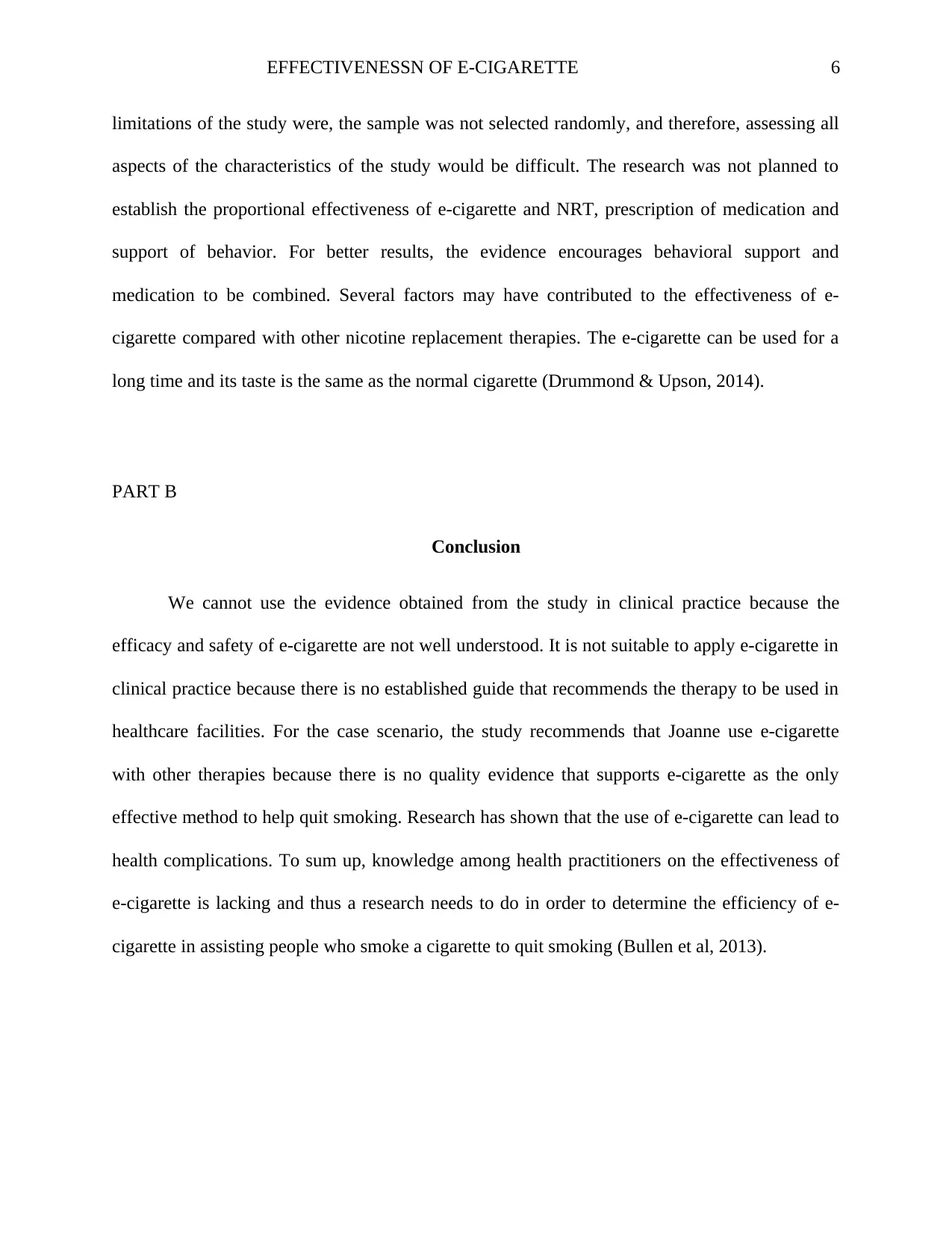
EFFECTIVENESSN OF E-CIGARETTE 6
limitations of the study were, the sample was not selected randomly, and therefore, assessing all
aspects of the characteristics of the study would be difficult. The research was not planned to
establish the proportional effectiveness of e-cigarette and NRT, prescription of medication and
support of behavior. For better results, the evidence encourages behavioral support and
medication to be combined. Several factors may have contributed to the effectiveness of e-
cigarette compared with other nicotine replacement therapies. The e-cigarette can be used for a
long time and its taste is the same as the normal cigarette (Drummond & Upson, 2014).
PART B
Conclusion
We cannot use the evidence obtained from the study in clinical practice because the
efficacy and safety of e-cigarette are not well understood. It is not suitable to apply e-cigarette in
clinical practice because there is no established guide that recommends the therapy to be used in
healthcare facilities. For the case scenario, the study recommends that Joanne use e-cigarette
with other therapies because there is no quality evidence that supports e-cigarette as the only
effective method to help quit smoking. Research has shown that the use of e-cigarette can lead to
health complications. To sum up, knowledge among health practitioners on the effectiveness of
e-cigarette is lacking and thus a research needs to do in order to determine the efficiency of e-
cigarette in assisting people who smoke a cigarette to quit smoking (Bullen et al, 2013).
limitations of the study were, the sample was not selected randomly, and therefore, assessing all
aspects of the characteristics of the study would be difficult. The research was not planned to
establish the proportional effectiveness of e-cigarette and NRT, prescription of medication and
support of behavior. For better results, the evidence encourages behavioral support and
medication to be combined. Several factors may have contributed to the effectiveness of e-
cigarette compared with other nicotine replacement therapies. The e-cigarette can be used for a
long time and its taste is the same as the normal cigarette (Drummond & Upson, 2014).
PART B
Conclusion
We cannot use the evidence obtained from the study in clinical practice because the
efficacy and safety of e-cigarette are not well understood. It is not suitable to apply e-cigarette in
clinical practice because there is no established guide that recommends the therapy to be used in
healthcare facilities. For the case scenario, the study recommends that Joanne use e-cigarette
with other therapies because there is no quality evidence that supports e-cigarette as the only
effective method to help quit smoking. Research has shown that the use of e-cigarette can lead to
health complications. To sum up, knowledge among health practitioners on the effectiveness of
e-cigarette is lacking and thus a research needs to do in order to determine the efficiency of e-
cigarette in assisting people who smoke a cigarette to quit smoking (Bullen et al, 2013).
⊘ This is a preview!⊘
Do you want full access?
Subscribe today to unlock all pages.

Trusted by 1+ million students worldwide
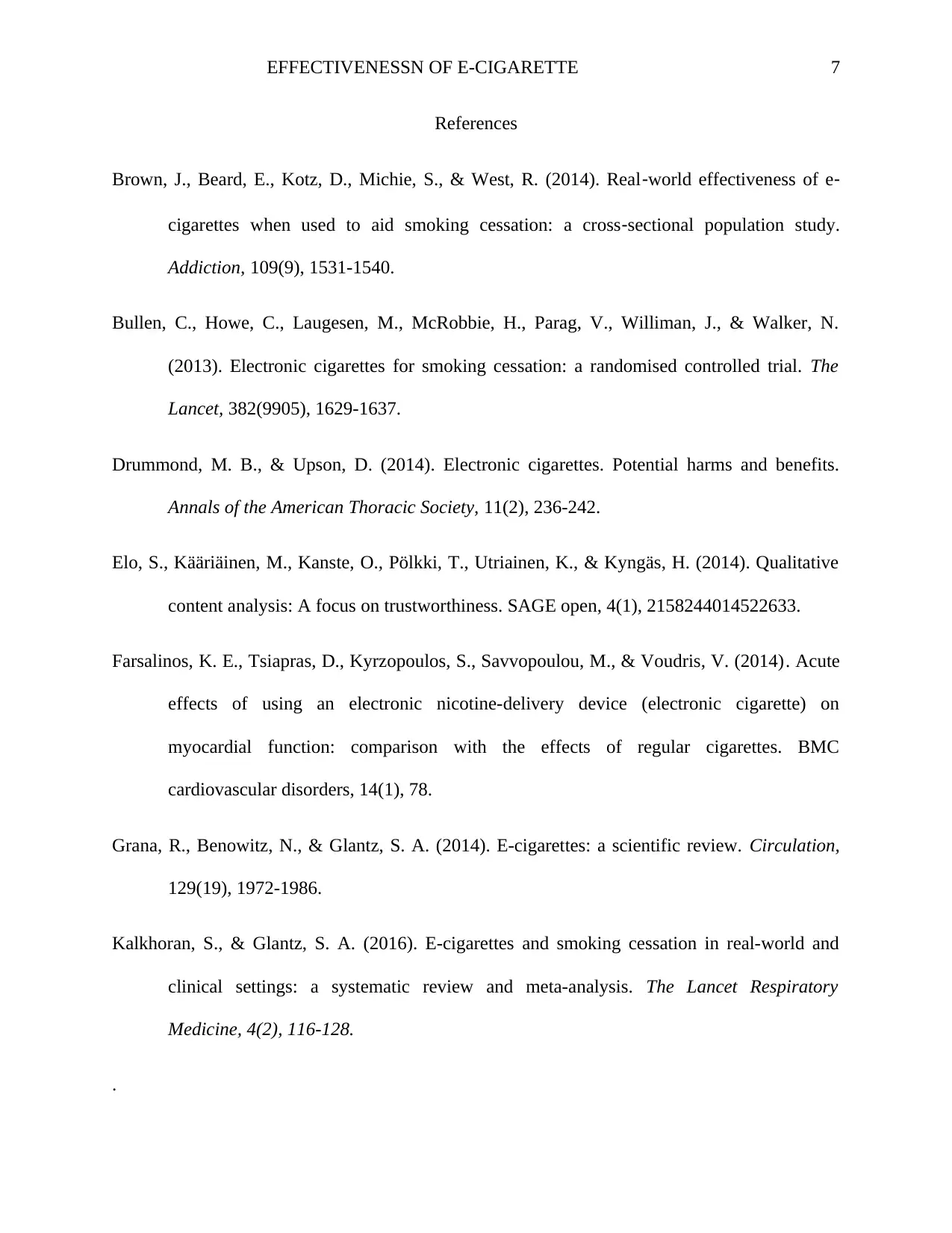
EFFECTIVENESSN OF E-CIGARETTE 7
References
Brown, J., Beard, E., Kotz, D., Michie, S., & West, R. (2014). Real‐world effectiveness of e‐
cigarettes when used to aid smoking cessation: a cross‐sectional population study.
Addiction, 109(9), 1531-1540.
Bullen, C., Howe, C., Laugesen, M., McRobbie, H., Parag, V., Williman, J., & Walker, N.
(2013). Electronic cigarettes for smoking cessation: a randomised controlled trial. The
Lancet, 382(9905), 1629-1637.
Drummond, M. B., & Upson, D. (2014). Electronic cigarettes. Potential harms and benefits.
Annals of the American Thoracic Society, 11(2), 236-242.
Elo, S., Kääriäinen, M., Kanste, O., Pölkki, T., Utriainen, K., & Kyngäs, H. (2014). Qualitative
content analysis: A focus on trustworthiness. SAGE open, 4(1), 2158244014522633.
Farsalinos, K. E., Tsiapras, D., Kyrzopoulos, S., Savvopoulou, M., & Voudris, V. (2014). Acute
effects of using an electronic nicotine-delivery device (electronic cigarette) on
myocardial function: comparison with the effects of regular cigarettes. BMC
cardiovascular disorders, 14(1), 78.
Grana, R., Benowitz, N., & Glantz, S. A. (2014). E-cigarettes: a scientific review. Circulation,
129(19), 1972-1986.
Kalkhoran, S., & Glantz, S. A. (2016). E-cigarettes and smoking cessation in real-world and
clinical settings: a systematic review and meta-analysis. The Lancet Respiratory
Medicine, 4(2), 116-128.
.
References
Brown, J., Beard, E., Kotz, D., Michie, S., & West, R. (2014). Real‐world effectiveness of e‐
cigarettes when used to aid smoking cessation: a cross‐sectional population study.
Addiction, 109(9), 1531-1540.
Bullen, C., Howe, C., Laugesen, M., McRobbie, H., Parag, V., Williman, J., & Walker, N.
(2013). Electronic cigarettes for smoking cessation: a randomised controlled trial. The
Lancet, 382(9905), 1629-1637.
Drummond, M. B., & Upson, D. (2014). Electronic cigarettes. Potential harms and benefits.
Annals of the American Thoracic Society, 11(2), 236-242.
Elo, S., Kääriäinen, M., Kanste, O., Pölkki, T., Utriainen, K., & Kyngäs, H. (2014). Qualitative
content analysis: A focus on trustworthiness. SAGE open, 4(1), 2158244014522633.
Farsalinos, K. E., Tsiapras, D., Kyrzopoulos, S., Savvopoulou, M., & Voudris, V. (2014). Acute
effects of using an electronic nicotine-delivery device (electronic cigarette) on
myocardial function: comparison with the effects of regular cigarettes. BMC
cardiovascular disorders, 14(1), 78.
Grana, R., Benowitz, N., & Glantz, S. A. (2014). E-cigarettes: a scientific review. Circulation,
129(19), 1972-1986.
Kalkhoran, S., & Glantz, S. A. (2016). E-cigarettes and smoking cessation in real-world and
clinical settings: a systematic review and meta-analysis. The Lancet Respiratory
Medicine, 4(2), 116-128.
.
Paraphrase This Document
Need a fresh take? Get an instant paraphrase of this document with our AI Paraphraser
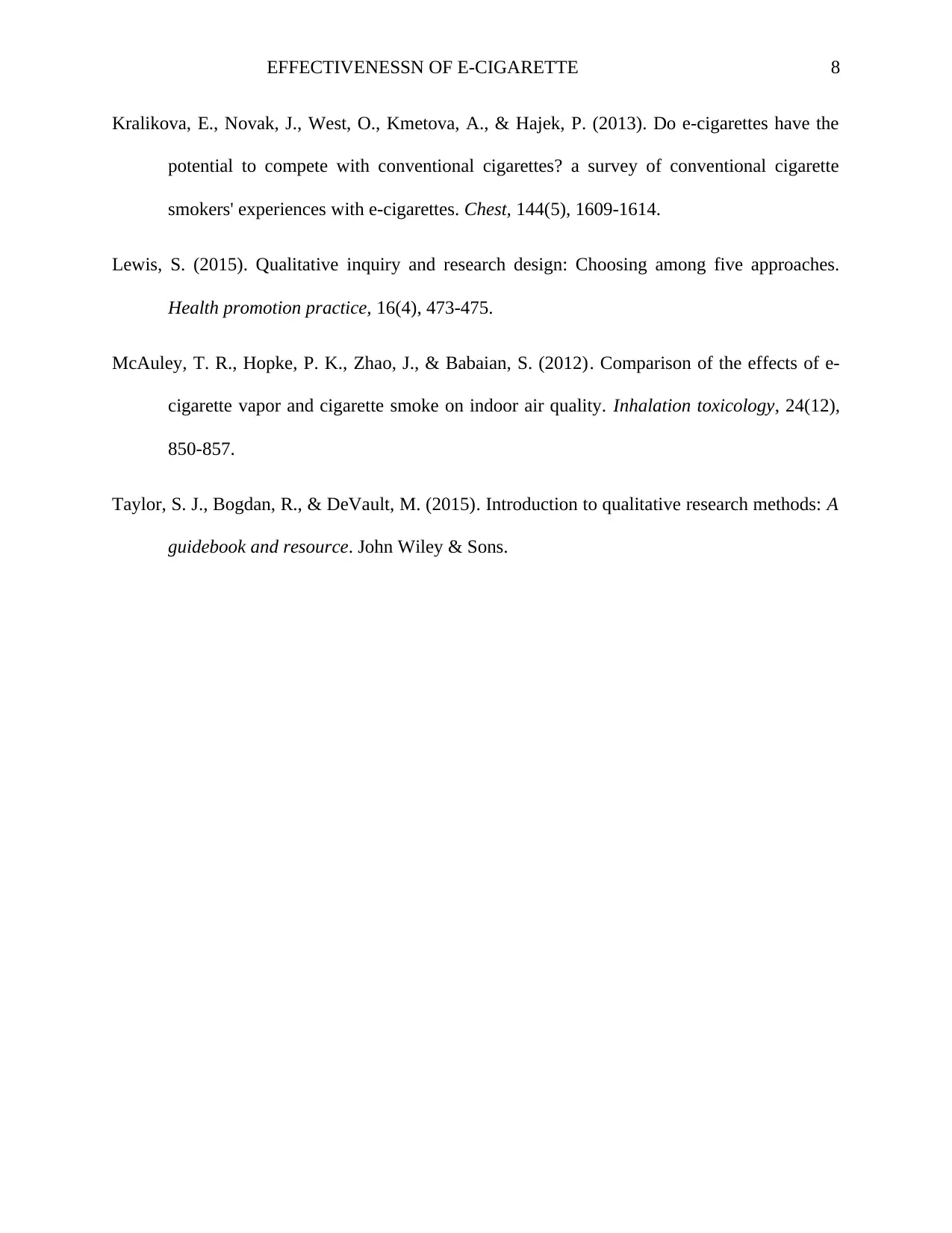
EFFECTIVENESSN OF E-CIGARETTE 8
Kralikova, E., Novak, J., West, O., Kmetova, A., & Hajek, P. (2013). Do e-cigarettes have the
potential to compete with conventional cigarettes? a survey of conventional cigarette
smokers' experiences with e-cigarettes. Chest, 144(5), 1609-1614.
Lewis, S. (2015). Qualitative inquiry and research design: Choosing among five approaches.
Health promotion practice, 16(4), 473-475.
McAuley, T. R., Hopke, P. K., Zhao, J., & Babaian, S. (2012). Comparison of the effects of e-
cigarette vapor and cigarette smoke on indoor air quality. Inhalation toxicology, 24(12),
850-857.
Taylor, S. J., Bogdan, R., & DeVault, M. (2015). Introduction to qualitative research methods: A
guidebook and resource. John Wiley & Sons.
Kralikova, E., Novak, J., West, O., Kmetova, A., & Hajek, P. (2013). Do e-cigarettes have the
potential to compete with conventional cigarettes? a survey of conventional cigarette
smokers' experiences with e-cigarettes. Chest, 144(5), 1609-1614.
Lewis, S. (2015). Qualitative inquiry and research design: Choosing among five approaches.
Health promotion practice, 16(4), 473-475.
McAuley, T. R., Hopke, P. K., Zhao, J., & Babaian, S. (2012). Comparison of the effects of e-
cigarette vapor and cigarette smoke on indoor air quality. Inhalation toxicology, 24(12),
850-857.
Taylor, S. J., Bogdan, R., & DeVault, M. (2015). Introduction to qualitative research methods: A
guidebook and resource. John Wiley & Sons.
1 out of 8
Related Documents
Your All-in-One AI-Powered Toolkit for Academic Success.
+13062052269
info@desklib.com
Available 24*7 on WhatsApp / Email
![[object Object]](/_next/static/media/star-bottom.7253800d.svg)
Unlock your academic potential
Copyright © 2020–2025 A2Z Services. All Rights Reserved. Developed and managed by ZUCOL.



